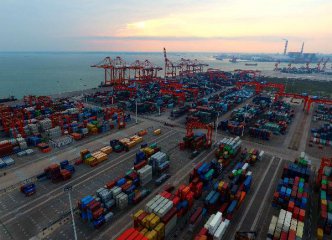Cyprus's sovereign credit rating has been affirmed at just one notch below investment grade with a positive outlook by Standard and Poors' rating agency, a statement made available in Cyprus on Saturday said.
The statement by the rating agency said that it could consider raising its present BB+/B rating to investment grade later in 2018, provided that economic recovery following the 2013 bailout of Cyprus will still provide "impetus for further meaningful general government and private sector debt reduction."
It added that the rating agency also expects to see a decline in Cyprus's short term debt burden and a further convergence of the island's monetary conditions with those of the Eurozone via a material reduction of unusually high non-performing loans (NPLs).
But at the same time it warned that its outlook could be revised from positive to stable should there be a lower than expected growth or a decline in the reduction of the government debt, and also a greater concentration of the economy on certain sectors, such as construction and tourism.
Cyprus's economic recovery since it was bailed-out under a 10-billion-euro economic assistance package in March 2013 has been spectacular, having reached a growth rate of 3.9 percent last year.
S&P projected real GDP growth at an average 2.8 percent over the period 2018 to 2021 through investment activity and service exports, while private consumption decelerates as households increase debt servicing.
Cyprus's government and opposition parties concluded at a meeting this week that the island's most severe problem currently is the high level of private debt and the high level of non-performing loans which threaten the stability of the banking system.
Putting aside partisan considerations, they agreed to set up a joint technocratic committee which was mandated to come up by the end of next week with suggestions on ways to bring down NPLs.
A prominent feature of their agreement was the protection of the primary residence of low income home owners and of the premises of small businesses.
They also agreed that their joint committee must suggest ways of forcing through legislation "strategic defaulters" - loan owners who have money but refuse to pay-up in the expectation that they will be offered debt relief - to start servicing their debts.
Despite an energetic program of loan restructuring over the past two to three years, NPLs still stand at about 20 billion euros (24.59 billion U.S. dollars), or 43 percent of the total loan portfolios of the banks, down from about 28 billion euros. (1 euro=1.23 U.S. dollars)
The statement by the rating agency said that it could consider raising its present BB+/B rating to investment grade later in 2018, provided that economic recovery following the 2013 bailout of Cyprus will still provide "impetus for further meaningful general government and private sector debt reduction."
It added that the rating agency also expects to see a decline in Cyprus's short term debt burden and a further convergence of the island's monetary conditions with those of the Eurozone via a material reduction of unusually high non-performing loans (NPLs).
But at the same time it warned that its outlook could be revised from positive to stable should there be a lower than expected growth or a decline in the reduction of the government debt, and also a greater concentration of the economy on certain sectors, such as construction and tourism.
Cyprus's economic recovery since it was bailed-out under a 10-billion-euro economic assistance package in March 2013 has been spectacular, having reached a growth rate of 3.9 percent last year.
S&P projected real GDP growth at an average 2.8 percent over the period 2018 to 2021 through investment activity and service exports, while private consumption decelerates as households increase debt servicing.
Cyprus's government and opposition parties concluded at a meeting this week that the island's most severe problem currently is the high level of private debt and the high level of non-performing loans which threaten the stability of the banking system.
Putting aside partisan considerations, they agreed to set up a joint technocratic committee which was mandated to come up by the end of next week with suggestions on ways to bring down NPLs.
A prominent feature of their agreement was the protection of the primary residence of low income home owners and of the premises of small businesses.
They also agreed that their joint committee must suggest ways of forcing through legislation "strategic defaulters" - loan owners who have money but refuse to pay-up in the expectation that they will be offered debt relief - to start servicing their debts.
Despite an energetic program of loan restructuring over the past two to three years, NPLs still stand at about 20 billion euros (24.59 billion U.S. dollars), or 43 percent of the total loan portfolios of the banks, down from about 28 billion euros. (1 euro=1.23 U.S. dollars)





















Latest comments